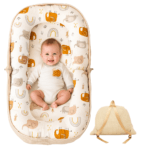Introducing a game-changing solution for sleep-deprived parents – the 40-Second Baby Sleep Miracle! If you’re a parent who’s struggled with restless nights and a fussy baby, you’re not alone. This article unveils a proven method that promises to have your little one peacefully drifting off to sleep in just 40 seconds. Say goodbye to hours of pacing and shushing, and welcome the gift of restful nights for you and your baby.
Getting a baby to sleep quickly can be challenging, but with the right techniques, it’s possible. This guide offers effective tips to help you soothe your baby and establish a bedtime routine, ensuring they drift off to sleep peacefully within 40 seconds. We’ll delve into the science behind this technique of How To Put A Baby To Sleep In 40 Seconds, step-by-step instructions, and essential safety tips. Get ready to transform bedtime into a tranquil experience for your familylife.
What do baby sleep cycles entail?

Baby sleep cycles refer to the recurring patterns of sleep stages that infants go through during their rest. These cycles are distinct from adult sleep cycles and play a vital role in a baby’s overall sleep quality and development.
A typical baby sleep cycle consists of two main stages: REM (Rapid Eye Movement) and non-REM sleep. REM sleep characterized by rapid eye movements, increased brain activity, and where most dreams occur. Non-REM sleep is dividing into several stages, with deep sleep being the most refreshing.
Unlike adults, babies have shorter sleep cycles, usually lasting around 50-60 minutes. This means they transition between REM and non-REM sleep more frequently. Understanding these cycles is crucial for parents, as it helps them recognize when their baby is in a deep sleep phase, making it easier to put them down and ensure longer, more restful periods of sleep.
Read to know : why do babies sleep with their butt in the air
What are the common sleep challenges with baby sleep cycles?
Common sleep challenges associated with baby sleep cycles often include frequent nighttime awakenings, difficulty in self-soothing, and short sleep cycles. Babies naturally have shorter sleep cycles, typically lasting around 50-60 minutes, leading to more frequent wake-ups. Many infants also struggle with transitioning between sleep stages, so parents must offer comforting techniques such as gentle rocking or shushing. Furthermore, teething, growth spurts, and developmental milestones can disrupt sleep patterns.
Parents can establish a consistent bedtime routine to address these challenges, create a soothing sleep environment, and be patient. In contrast, their baby’s sleep cycles mature and become more conducive to longer restful sleep.
How many minutes does it take for a baby to fall asleep?
The time it takes for a baby to fall asleep can vary widely from one baby to another. On average, it may take 10 to 20 minutes for a baby to fall asleep if they are drowsy and in a conducive sleep environment. However, some babies may fall asleep more quickly, while others may take longer, especially if they are overtired, fussy, or experiencing discomfort. Parents must be patient and create a consistent bedtime routine to help their baby establish healthy sleep habits.
Additionally, soothing techniques, such as gentle rocking or soft music, can also aid in helping a baby fall asleep more comfortably and quickly.
How To Put A Baby to Sleep In 40 Seconds?

Now, let’s dive into the technique that promises to put your baby to sleep in 40 seconds or less.
Gentle Swaddling
Swaddling is a tried-and-true method that mimics the snug feeling of the womb. Use a soft, breathable swaddle blanket to wrap your baby snugly, but be sure not to cover them too tightly, allowing some movement of the hips.
Rocking and Shushing
Gently rock your swaddled baby while making a “shushing” sound. This combination of motion and calming noise can work wonders in lulling your baby to sleep.
Rocking and shushing are two classic techniques often employed by parents to help their babies fall asleep. These methods are known for their calming effects and can be particularly effective during a baby’s bedtime routine.
Rocking: Gently rocking a baby back and forth, whether in a cradle, a rocking chair, or in your arms, mimics the soothing motion babies experience in the womb. This rhythmic movement can be incredibly comforting and help a fussy or restless baby settle down.
Shushing: Creating a “shushing” sound, like a gentle breeze or flowing water, can mimic the comforting sounds of the womb. The consistent and rhythmic noise can drown out other disruptive sounds and lull the baby into a peaceful sleep.
Use a Pacifier: If your baby uses a pacifier, offering it can help them self-soothe and fall asleep faster.
Cradle Hold: Hold your baby in a cradling position, with their head supported and slightly elevated. This can provide comfort and security.
Light Back Patting: Gently pat or rub your baby’s back in a rhythmic pattern to help them relax and drift off.
Stay Calm and Relaxed: Babies can sense your stress, so it’s important to remain calm and patient. Your relaxed demeanor will help your baby feel more secure and ready to sleep.
Maintain a Consistent Routine
Maintaining a consistent routine is crucial in ensuring a baby’s healthy sleep patterns and overall well-being. Babies thrive on predictability, and having a bedtime routine can signal them that it’s time to wind down and prepare for sleep. Consistency in activities like bathing, reading bedtime stories, gentle rocking, or singing a lullaby helps establish sleep associations and cues the baby can recognize. Over time, this routine becomes a reassuring signal that promotes a sense of security, making it easier for the baby to transition into sleep. Consistency aids in setting a stable sleep schedule, reducing nighttime awakenings and promoting better quality sleep for both the baby and the parents.
White noise machine
A white noise machine for baby sleep is a valuable tool designed to create a peaceful and calming auditory environment to help infants sleep more soundly. These devices emit a consistent and soothing sound that mimics the “white noise,” effectively masking other disruptive noises that might wake a baby during sleep.
The white noise produced by these machines helps in several ways:
- Sound Masking: It covers up sudden noises, like traffic or household sounds, ensuring a quieter sleep space for the baby.
- Sleep Association: Babies can learn to associate white noise with sleep, making it a cue to relax and drift off.
- Improved Sleep Patterns: White noise machines can lead to more extended and deeper sleep, reducing nighttime awakenings.
Running water
The sound of running water has a calming and sleep-inducing effect on many babies. It mimics the soothing environment of the womb, where the gentle sway of amniotic fluid surrounds them. Running water’s rhythmic, repetitive nature can help lull a fussy or restless baby to sleep. Many parents use techniques like running a faucet, using a white noise machine with a water setting, or playing recordings of babbling brooks or ocean waves to create this calming sound. It provides a comforting backdrop that masks other noises and can aid in settling a baby into a peaceful slumber, making it a popular choice for bedtime routines.
Using touch to relax a baby

Using touch to relax a baby is a powerful and nurturing technique for promoting peaceful sleep. Gentle, rhythmic touches, such as soothing strokes on the baby’s back, patting, or gentle rocking, can provide comfort and a sense of security. Skin-to-skin contact, like cuddling or holding the baby close, releases oxytocin, a bonding hormone that helps both baby and caregiver feel calm and connected. Additionally, a warm and gentle massage with baby-safe lotion can relax tense muscles and improve circulation, enhancing the baby’s overall comfort. Incorporating touch into a bedtime routine fosters a sense of safety and affection, making it easier for the baby to settle down and drift into a restful slumber.
Chanting
Chanting is a calming technique to help a baby fall asleep quickly. The rhythmic and repetitive nature of chanting can create a soothing environment for the baby, promoting relaxation and drowsiness.
Here’s how you can use chanting for baby sleep in 40 seconds:
Choose a Simple Chant: Select a short and gentle chant or mantra. It could be as simple as softly repeating “shhh” or “hush” in a rhythmic manner.
- Hold and Comfort Your Baby: Cradle your baby in your arms or place them in their crib while holding them. Make sure your baby is comfortable and feels secure.
- Begin Chanting: Start chanting the chosen word or phrase softly and steadily. You can synchronize your vocalizing with gentle rocking or patting to enhance the soothing effect.
- Maintain Eye Contact: Maintain eye contact with your baby, offering them a sense of connection and reassurance.
- Observe Your Baby: Pay attention to your baby’s cues. As they relax and become drowsy, you can gradually reduce the intensity of your chanting.
Use calming lotions at bedtime.
Calming lotions at bedtime are an excellent way to enhance a soothing and relaxing bedtime routine for babies and young children. These specially formulated lotions often contain gentle, natural ingredients like lavender, chamomile, or calendula, known for their calming properties. Applying the lotion as part of the bedtime ritual provides a comforting sensory experience, as the gentle massage relaxes tense muscles and nourishes the skin.
The calming scents help create a serene atmosphere, signaling the child that it’s time to wind down and prepare for sleep. This sensory association can make bedtime a more peaceful and enjoyable experience, contributing to better sleep for both the child and the parent.
Creating the Ideal Sleep Environment to Sleep Baby in 40 Seconds
Creating the ideal sleep environment is paramount to helping a baby fall asleep quickly, ideally within 40 seconds. Here are key points to consider:
Dim Lighting:
- Ensure the sleeping area is dimly lit. Soft, low-intensity lighting can signal the baby that it’s time to sleep. Consider using blackout curtains to block out external light sources.
Comfortable Temperature:
- Maintain a comfortable room temperature, typically between 68°F to 72°F (20°C to 22°C). Dress your baby in appropriate sleepwear to avoid overheating or chilling.
Safe Sleep Space:
- Ensure the crib or bassinet is free from loose bedding, pillows, or toys, following safe sleep guidelines provided by organizations like the American Academy of Pediatrics (AAP).
Comfortable Bedding:
- Use a comfortable and firm mattress with a fitted crib sheet. Avoid excessive padding, as it can pose a suffocation risk.
Cozy Swaddling:
- Consider swaddling your baby in a soft, breathable swaddle blanket. This can provide a sense of security and mimic the snug feeling of the womb.
Routine and Consistency:
- Establish a consistent bedtime routine, including bathing, reading a book, or gently rocking. Consistency in these activities can signal the baby that sleep time is approaching.
- By meticulously attending to these points, you can create a tranquil and comfortable sleep environment that promotes rapid sleep onset. Remember that each baby is unique, so it may take some trial and error to determine the best elements for your child.
What if my baby still doesn’t sleep after trying these techniques?
If your baby continues to experience sleep difficulties despite trying various techniques, it can be understandably frustrating and concerning for parents. Here are some steps to consider:
Consult a Pediatrician:
If persistent sleep troubles persist, it’s advisable to seek guidance from a pediatrician. There may be underlying medical issues, such as reflux, allergies, or sleep disorders, that must be addressed.
Evaluate Sleep Schedule:
Reassess your baby’s sleep schedule. Ensure they get adequate daytime sleep to prevent overtiredness, which can make it more challenging for them to settle at night.
Consistency is Key:
Maintain consistency in your bedtime routine and sleep environment. Babies thrive on predictability, and a consistent performance can help signal that it’s time to sleep.
Monitor Diet:
Pay attention to your baby’s feeding schedule. Hunger can disrupt sleep, so ensure they are well-fed before bedtime.
Consider Sleep Training:
For older babies (usually six months or older), sleep training methods like Ferber or the “cry it out” approach may be considered, with guidance from a pediatrician.
Parental Self-Care:
Caring for a baby with sleep difficulties can be exhausting. Ensure you’re taking care of your well-being, seeking support from friends and family when needed.
Remember that every baby is unique, and what works for one may not work for another. Be patient, and consult with healthcare professionals for personalized advice. Sleep patterns can evolve as your baby grows, and with time, you may discover strategies that help them establish healthy sleep habits and enjoy more restful nights.
FAQs
Is swaddling safe for all babies? Swaddling is generally safe but may not be suitable for all babies. Consult your pediatrician for guidance.
How long should I use the 40-second technique?
The 40-second technique is effective for newborns and young infants. As your baby grows, their sleep patterns will change, and you may need to adjust your bedtime routine.
Can I use a pacifier while using the 40-second technique?
Yes, a pacifier can be soothing for many babies. If your baby is comfortable, you can offer a pacifier while employing the 40-second technique.
What is the quickest method to put a baby to sleep?
The fastest way to help a baby fall asleep is often a combination of techniques. Swaddling, gentle rocking, and using white noise can be effective. However, every baby is unique, so it may require trial and error to determine what works best for your child.
Conclusion
Putting your baby to sleep quickly doesn’t have to be an impossible task. By understanding your baby’s sleep patterns, creating a calming environment, and using the 40-second technique, you can make bedtime a more peaceful experience for you and your little one. Remember that every baby is unique, so be patient and flexible as you discover what works best for your child.















